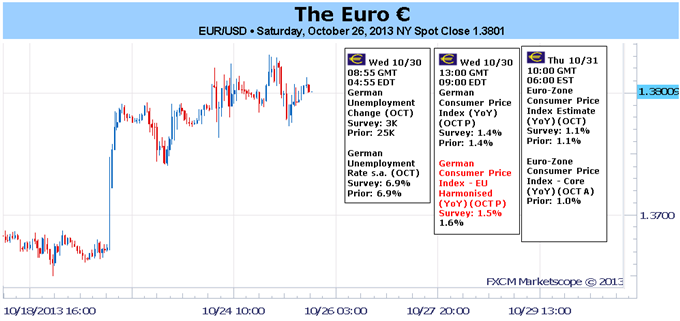
Fundamental Forecast for Euro: Bullish
– The weak September US NFP report helped lift the EURUSD to new 2013 highs.
– The Euro was able to rebound against the commodity currencies as tensions in Chinese markets arose.
– Mixed PMI surveys didn’t deter Euro bulls – sign of evolving sentiment?
The Euro was the second best performing currency this week overall, gaining another +0.84% against the US Dollar and closing above $1.3800 (1.3802 in New York on Friday) for the first time since November 2011. The recent theme dominating Euro trading continued to persist: as long as there are signs of a continued economic recovery, the Euro should have the opportunity to rally with the European Central Bank remaining on the sidelines.
The Euro’s gains this week extended beyond the safe have complex which hadn’t been the case in weeks past, although the outperformance exhibited against the commodity currencies (the Australian, Canadian, and New Zealand Dollars) wasn’t necessarily due to incoming economic data performing in excess of expectations. Rather, risk aversion remained elevated in the wake of the US fiscal deal, though emanating from Asia (Chinese liquidity concerns), not North America (US fiscal and monetary uncertainty).
Market participants are seemingly adjusting their outlook on the Euro in a more positive light as these international issues bubble up. Although October French, German, and broader Euro-Zone PMI survey data slipped overall from September (signaling slower growth), the simple fact that growth conditions remain buoyed seemed to be the ‘big picture’ takeaway, as the Euro ultimately rallied on this week’s mixed data releases.
Even if the Chinese liquidity concerns abate thereby removing a negative fundamental influence on the commodity currencies, the Euro appears poised to perform well in its own right as incoming economic data looks set to restart its slow rebound. The German GfK Confidence Survey for November on Tuesday should improve, signaling that consumers in the Euro-Zone’s largest economy see an improving economy over the coming month. A beat here (7.2 expected from 7.1) would lay the groundwork for positivity around the Euro at the start of the week.
Wednesday’s economic docket poses the most risk to the Euro, though the expected uptick in volatility resulting from the data releases may prove to favor further Euro gains. The 3Q’13 Spanish GDP report will be released on Wednesday, and while the yearly figure should show a continued recession (-1.2% from -1.6% (y/y)), the quarterly reading may show meager growth (+0.1% from -0.1% (q/q)) for the first time since the 1Q’11 (+0.2%). While these data hardly suggest the crisis is over, the psychological effect of seeing positive growth figures in the periphery may be significant.
Alongside the rebound in peripheral growth data, German labor market data for October on Wednesday should show that the labor market weakness evident the past few months may have been alleviated. The German economy tends to lead the Euro-Zone; and therefore signs that Germany’s labor market is no longer weakening at present time will help bolster confidence in the broader region’s economic rebound through the end of the year.
Overall, the Euro economic calendar for the coming week paints a picture of improving growth, with the lull that set in towards the end of the summer now working its way out of the regional economy. One can’t dismiss the impact that the Federal Reserve’s October policy meeting might have on the Euro as well; although with the Fed’s stance arguably becoming more dovish at a time when the ECB remains in neutral, we suspect that a hold of QE3 at $85B/month will prove EUR-positive once again. –CV
To receive reports from this analyst, sign up for Christopher’s distribution list.
DailyFX provides forex news and technical analysis on the trends that influence the global currency markets.Learn forex trading with a free practice account and trading charts from FXCM.
Source: Daily fx

